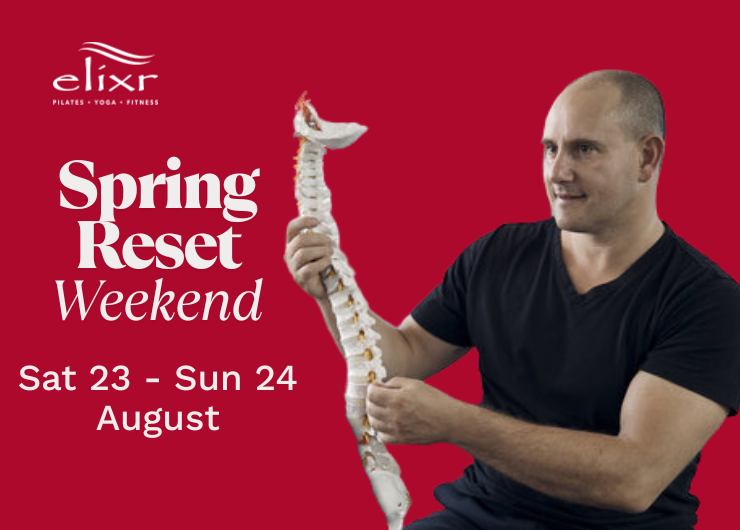Stand Taller, Move Better: Why Posture Is Foundational to Your Health
To help you better understand the role posture plays in everything from mobility to mental clarity, Dr Steve from MyChiro will be leading a free, 30-minute workshop at Elixr:
🗓 Saturday 24 August
🕛 12:00pm – 12:30pm
📍 Muhammad Ali (Group X)
In this session, you’ll learn:
- What healthy posture really looks and feels like
- How to identify common patterns that lead to discomfort or injury
- Simple techniques you can use daily to improve alignment and reduce strain
- The link between posture, breathing, and nervous system health
No jargon. No heavy theory. Just practical insights you can use right away to move, feel, and function better.
Before the workshop, Dr Steve will also be offering free posture checks at the Spring Reset Weekend Partner Market Day from 10:00am to 12:00pm. If you’re curious about how your posture is tracking, or want quick, personalised feedback, feel free to drop by—no appointment needed.
REDEEM YOUR COMPLIMENTARY 5 DAY PASS
Posture isn’t just about how you look in a mirror or whether you’re sitting up straight—it’s about how well your body supports itself, moment to moment, movement to movement.
At Elixr, where mindfulness, mobility, and strength converge, we see posture not as a cosmetic detail, but as a reflection of how the spine, nervous system, and muscular control are working together. Whether you’re flowing through a yoga class, powering through Pilates, or simply walking out into your day, good posture makes all of it easier, more efficient, and less taxing on the body.
But in today’s world, even the most health-conscious among us can develop subtle postural imbalances. The truth is, posture is always adapting—to the way we sit, the way we move (or don’t), and the habits we repeat, often without noticing.
Over time, those adaptations can create issues: back and neck pain, tension headaches, reduced range of motion, slower recovery from exercise, and fatigue that doesn’t quite add up. These aren’t always “injuries”—they’re often signs your posture is no longer working with you.
So what can you do about it?
Understanding Posture as a System
Posture is less about holding a position and more about how your body organises itself against gravity. It’s dynamic. It changes with every breath, every movement, every thought.
That’s why simply trying to “sit up straight” often doesn’t last—because it’s not about effort, it’s about integration.
Key systems involved in posture include:
- Spinal alignment – ensuring your vertebrae are moving and stacking in healthy patterns
- Core stability – supporting the spine with deep, coordinated muscle activation
- Breath mechanics – allowing the diaphragm to function fully for better oxygenation and ribcage mobility
- Neuromuscular control – the brain’s ability to sense and adjust your body’s position in space
When any of these systems are out of sync—due to prolonged sitting, past injuries, or training imbalances—posture becomes compensatory. You may not feel it right away, but you’ll notice it in the form of stiffness, soreness, or movement restrictions that linger.
Posture and Your Practice
For many Elixr members, physical activity is a cornerstone of their wellbeing. Whether it’s yoga, Pilates, strength training or functional movement, you’re investing time and energy into your health—and posture is what makes that investment sustainable.
When posture is working well:
- Movements become more fluid and efficient
- Breath deepens, especially in loaded or extended positions
- Recovery is faster, because the body isn’t fighting itself
- Strength can be built in balanced, safe ways
- Mental focus improves, as the body feels more at ease
But when posture is compromised, it can feel like something’s “off”—you can’t quite push as hard, reach as far, or feel as connected in your body. That’s where awareness—and assessment—comes in.
A Smarter, Gentle Approach to Improving Posture
Improving posture doesn’t mean rigidly “fixing” your body. It means giving it the input it needs to recalibrate—through breath, strength, mobility, and sometimes professional insight.
Here are five simple exercises you can incorporate into your gym or home routine to begin that process. They’re safe, accessible, and powerful when done consistently:
1. Wall Angels
Stand with your back against a wall, feet slightly forward, arms raised in a “goal post” shape. Slide your arms up and down the wall slowly, keeping contact throughout.
→ Improves thoracic mobility and shoulder control.
2. Bird-Dog
On all fours, extend opposite arm and leg while maintaining balance and spinal alignment. Pause, return, and repeat on the other side.
→ Enhances core control and postural stability.
3. Dead Bug
Lying on your back, raise arms and legs into a tabletop position. Lower opposite arm and leg while keeping your lower back connected to the floor.
→ Strengthens the deep core muscles that support your spine.
4. Dumbbell Rows
Using a neutral spine, perform bent-over rows with moderate weights. Focus on scapular retraction—drawing shoulder blades down and together.
→ Activates upper back muscles that oppose slouched posture.
5. Glute Bridges
Lie on your back with knees bent, lift your hips off the floor, hold, and return.
→ Engages the posterior chain—glutes and hamstrings—which helps stabilise the pelvis and lower back.
Each of these targets a key element of postural integrity. Done with intention, they help restore balance to the muscles and movement patterns that keep you upright and pain-free.




